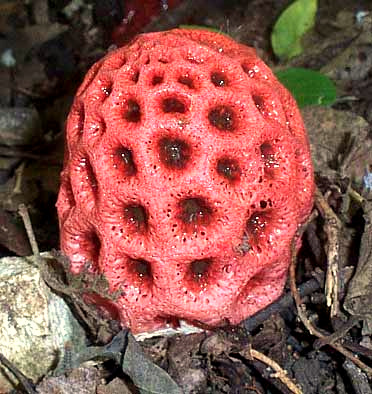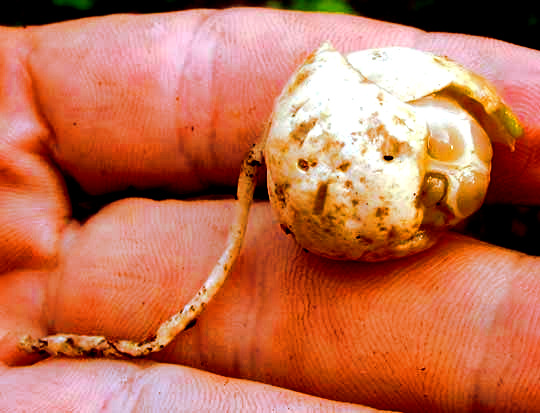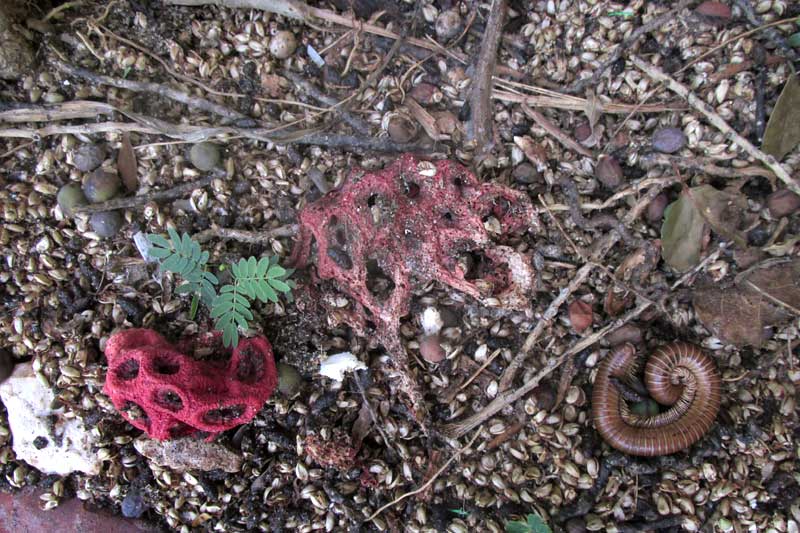Excerpts from Jim Conrad's
Naturalist Newsletter
from the July 27, 2007 Newsletter issued from Sierra Gorda Biosphere Reserve, QUERÉTARO, MÉXICO
WIFFLEBALL STINKHORNS

The strange object at the right is a fungus about the size of a baseball. Note the glistening, greenish-brown, very stinky, pasty goo inside the pores. That stuff's stench attracts insects such as flies who wander into the pores looking for putrefying flesh, mellowing manure and the like. The gunk gets on the insects' legs, they fly away and spread it on whatever they land on. That's good for the fungus since the slime has spores in it, and those spores can germinate to produce new fungi.
The fungus is CLATHRUS CRISPUS, and if it has an accepted English name I can't find it. In the US it occurs in Florida and along the Gulf Coast, but mostly it's found in Mexico and the Caribbean. The species belongs to the fungus family Phallaceae, that name based on the obvious English root. Longtime readers of this Newsletter may remember my January 27, 2002 issue where I reported on finding a stinkhorn in Mississippi. Country folks back there were liable to call the slender, pointed, red stinkhorn a Dog-pecker Mushroom, because that's what it looked like, and it smelled like this week's Clathrus crispus. Several other outlandish-looking stinkhorn species exist and you might enjoy browsing "The Stinkhorn Hall of Fame" at http://www.mushroomexpert.com/stinkhorn_fame.html.
About a dozen of this week's stinkers grew in a heavily shaded patch of scrub across the fence from my casita. I suspect that the reason the fungus grew there so gregariously but not anyplace else I visited during my hike is that sometimes folks from the shantytown next to the reservoir take craps there. Clathrus crispus is "saprobic," which means that it derives its nourishment from nonliving or decaying organic matter. Old crap that's worked its way into the soil must look pretty good to it.
from the May 30, 2010 Newsletter issued from Hacienda Chichen Resort beside Chichén Itzá Ruins, central Yucatán, MÉXICO
A STINKHORN "EGG"
This week as the garden crew dug a trench through the woods to lay some pipes they came upon the thing seen below:

When the thing was given to me it wasn't broken yet and I didn't know what it was. But then I squeezed it slightly, the shell shattered, and the honeycomb-like sphere appeared. Then I recognized it as the subterranean stage in the life history of the Wiffleball Stinkhorn, CLATHRUS CRISPUS, which seems to be fairly common in Mexico's humid areas. The dry, outer "shell" is known as the peridium. At maturity the peridium cracks open and remains in the soil, serving as the mushroom's cup, or volva, as the fruiting body emerges aboveground.
from the April 10 2016 Newsletter issued from Hacienda Chichen Resort beside Chichén Itzá Ruins, central Yucatán, MÉXICO
UAYCHIVO POOP
Word was going around our Maya staff that a uaychivo had pooped next to a building at the Hacienda. When the news reached me, I had to ask what a uaychivo is.
"They're bad people who at night turn themselves into an animal, then roam around doing bad things," I was told. The story continued that when the uaychivo poops it produces an egglike thing under the ground where the poop falls. The egglike thing then ripens and rises to the ground's surface where it forms the unnatural and terribly stinking thing spotted here. They told me where the uaychivo poop was so I went to photograph it, and it's shown below:

The flattish, faded object in the picture's center is an old one, and the reddish one at the lower left is fresher, though it, too, is fading. The dead millipede is the endemic Chichen Itza Bumblebee Millipede we looked at in February, described at www.backyardnature.net/mexnat/chichen.htm
The two pinkish, honeycombed things in the pictures aren't mysterious at all and we've encountered them several times. They're mushrooms sometimes called Wiffleball Stinkhorns, Clathrus crispus.
The stinkhorn's stench attracts flies and other critters looking for putrefied matter, the flies get the fungus's stinky goo on their legs, the goo contains the mushroom's spores, and then the fly flies away disseminating the spores, which is what the stinkhorn wants.